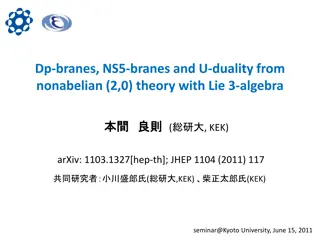Understanding Bowlby's Attachment Theory: A Comprehensive Overview
This content provides an in-depth exploration of Bowlby's Attachment Theory, covering key concepts such as stages of attachment, interactional synchrony, multiple attachments, imprinting, secure and insecure attachment styles, and the impact of maternal deprivation. It also delves into short-term and long-term separation effects on children, highlighting protest, despair, and detachment stages. Various studies and real-life examples are discussed to illustrate the importance of attachment in child development.
Download Presentation

Please find below an Image/Link to download the presentation.
The content on the website is provided AS IS for your information and personal use only. It may not be sold, licensed, or shared on other websites without obtaining consent from the author. Download presentation by click this link. If you encounter any issues during the download, it is possible that the publisher has removed the file from their server.
E N D
Presentation Transcript
Review: If this is the answer what was the question. Stages of attachment Interactional synchrony Multiple attachments Caregiverese Lorenz Imprinting Harlow Cloth Comfort Sensitive period Critical period Internal working model Learning theory Social releasers Cupboard love Cultural variations in attachment The Strange Situation Secure attachment Insecure attachment
3.5 Bowlbys Maternal Deprivation Hypothesis What does this mean?
Bowlby in his own words https://www.youtube.com/watch?v=3LM0nE81 mIE
Starter: A Two Year Old Goes To Hospital https://www.youtube.com /watch?v=s14Q-_Bxc_U Robertson (1952) film shows how short term separation results in distess. The Story of Laura Activity: Watch the clip and describe the child s reaction to separation.
Maternal Deprivation Hypothesis Short Term Bowlby predicts disruption to the attachment bond causes serious and permanent damage. Separation Long Term Deprivation Long Term Privation
Short-term separation Brief, temporary separations. Left with babysitter, day care, short hospital stay. PDD Model
Short-term separation Protest: The child cries, screams and protests angrily when the parent leaves. They will try to cling on to the parent to stop them leaving. Despair: The child s protesting begins to stop and they appear to be calmer although still upset. The child refuses others attempts for comfort and often seems withdrawn and uninterested in anything. Detachment: If separation continues the child will start to engage with other people again. They will reject the caregiver on their return and show strong signs of anger.
Short-term evaluation Alternative attachment can reduce harm done. 1. Robertson & Robertson (1971) Film Clips case studies. Correlation not causation. 2. Douglas (1975) separations less that a week of children aged 4 correlates with more behavioural difficulties. Individual differences in how children cope with separation.
Long-term deprivation Long-term more harmful than short-term deprivation Deprivation disruption of an attachment bond. Permanent separations: Divorce = resentment, stress. Death = depression. Divorce Imprisonment Death Adoption Individual differences. Strategies can be used to help with transition. Read the research on pg. 131
Real-Life Application: Women in prison The Law. Women who give birth in prison can keep their baby for the first 18 months in a mother and baby unit. Should mothers be separated from their young children in prison? Discuss? What are the best interests of the child? A prisoner with a child under 18 months old can apply to bring their child to prison with them. Social Services arrange for children over 18 months to be cared for, eg by the prisoner s parents, or fostering.
Evaluate the usefulness of this evidence. Long-term privation Case study evidence. Children who have never formed an attachment bond. Freud & Dann Children orphaned in Nazi concentration camps (Bulldog Bank children). No maternal attachment. Long lasting, permanent damage. Koluchova identical twins locked in a cellar by stepmother. Irreversible. Curtiss Wild child Genie The negative effects of privation can be overturned by positive experiences.
Genie https://www.youtube.com /watch?v=VjZolHCrC8E
Long-term privation Case studies are dependent on retrospective memory Unethical to do this research on humans so case studies are useful. Case studies are subjective
Institutionalisation Evidence? Institutional care provided by orphanages and children s homes. Mixture of privation and deprivation. Disinhibited attachment clingy, attention-seeking, indiscriminately sociable with adults. Affectionless psychopathy inability to show affection or concern to others.
Institutionalisation - Evidence Spitz (1946) South American orphanages children rarely talked to or picked up. Children were developmentally retarded and depressed. Bowlby (1944) compared 44 thieves with non-thieves. The thieves 32% exhibited affectionless psychopathy 86% of this group had suffered maternal deprivation. Tizard & Hodges (1978) Compared infants in care privation with those who were adopted with a natural parents group. Tested at 4 and 8 years institutionalised children have poor relationships and behavioural problems.
Romanian orphan studies https://www.youtube.com/ watch?v=SOS3jBy3bl4 https://www.youtube.com/ watch?v=TqKEUv82j0c https://www.youtube.com/ watch?v=rFMZljG2LEA
Rutter et al (1998) Developmental catch up Study A: Can love & care make up for deprivation? P: Longitudinal quasi experiment. DV cognitive functioning 111 Romanian orphans assessed on arrival to UK and again at age 4. IV age at adoption. R: 50% retarded on arrival. Great improvements at 4 years those adopted before 6 months almost same as normal British adopted children. C: The negative effects of institutionalisation can be overcome by sensitive, nuturing care. G. R. A. V. E. R
Other orphan studies. O Connnor et al (1999) many orphans display indiscriminate friendliness. Rutter (2001) follow up those orphans who had suffered long term institutionalisation continue to have attachment problems (only 20% showed normal functioning.)
Exam Questions. 1. Define and give an example of privation, deprivation and privation. (6 marks) 2. Explain what is meant by maternal deprivation. (3 marks). 3. Outline evidence that supports maternal deprivation (4 marks). 4. Explain one criticism of maternal deprivation theory. (4 marks) 5. Outline what is meant by institutionalisation. (2 marks) 6. Outline what research has found about the effects of institutionalisation on attachment. (6 marks). 7. Describe one study of Romanian orphans. Include what the researcher did and what they found. (4 marks) 8. Describe and evaluate Bowlby s Maternal Deprivation Theory.
Exam questions (Application A02) Ruby has a secure, loving relationship with her mother but her mother has to go into hospital. During this time Ruby must stay with someone she does not know. What strategies could be used to reduce any potential negative effects of Ruby s separation from her mother. (4 marks)
Exam questions (Application A02) Nadia was adopted when she was two. Prior to this she had lived in an orphanage. Now at 11 she is doing well but her teachers notice she has a tendency to be attention seeking with strangers. Referring to the effects of institutionalisation, explain why Nadia may be displaying this unusual social behaviour.























